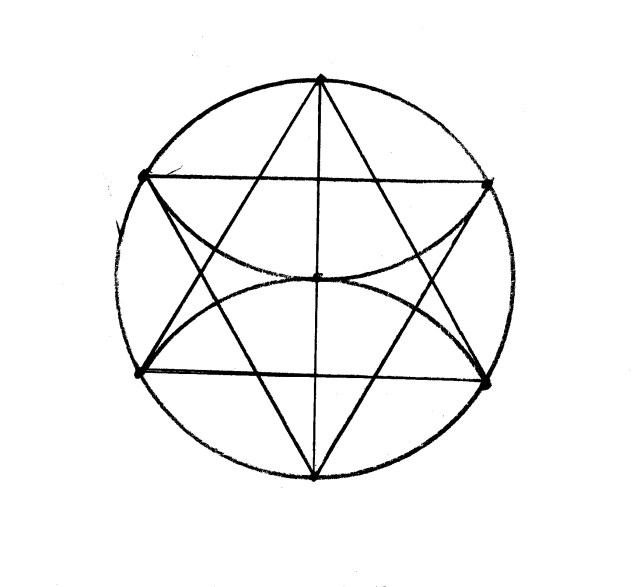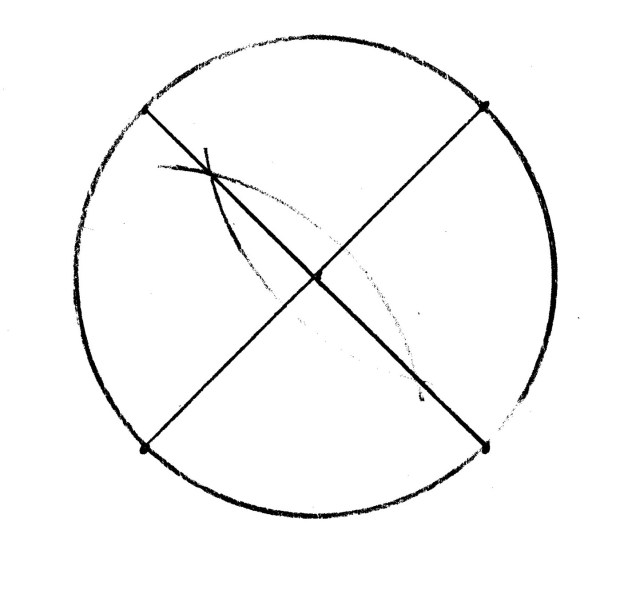In the spirit of the holidays, let’s perform some simple, ancient geometry to create the iconic symbols of the two religions celebrating major holidays this month. You’ll need only a compass, a straightedge, a piece of paper and a couple of candles to illuminate your work. In chronological order (in more ways than one) let’s start with Judaism’s Star of David:
Begin with a circle and mark the focal point. We have actually started with the symbol for Ra, the ancient Egyptian sun god for whom winter solstice was celebrated for thousands of years prior to Judaism – but that may or may not be another story.
Now draw a line vertically through the focal point (i.e. a diameter) and mark its intersection points at the rim.
Next set the compass to span from one of the rim intersection points to the focal point and swing an arc through the rim as shown. Mark the arc’s intersection points.
Repeat from the other rim intersection and mark two more rim points.
Connect all the rim points across the circle.
Erase the circle rim, diameter line and interior arcs and you are left with the Star of David.
Now let’s create the Christian cross – also from the intersection of line and circle:
Again we’ll start with a circle (which came to represent the heavens), but this time we’ll draw the diameter line at about a 45° angle.
Construct another diameter line at a right angle to the first. Use the intersecting arcs method (or just fudge it, I won’t tell).
Connect the rim intersection points to create a square (which traditionally represents the four directions, the four seasons and the earth itself).
Now bisect the lower horizontal line and extend the bisection line from the focal point down past the lower rim of the circle.
We’ll set our compass to the span between the rim intersection point and focal point, and swing a second circle. (A second of a pair of circles traditionally represented the Dyad … the reflection, the knowing of the first circle called the Monad (all one/alone).)
When we erase most of the lines we are left with a cross … a symbol of the melding of heaven with earth. Or for the math geeks: a pairing of a diameter line (2) with the non-terminating (i.e. irrational) square root of two.
Note: This geometric construction of the cross is not historical but rather the product of my imagination.
— Jim Tolpin, one of the authors of “From Truths to Tools“















LOVE. Your new book is the gift of the year for several of my friends and family members.
How delightful it is to learn geometry without working through the usual theorem proofs!
No one has time for proofs anymore!
Be nice to us math geeks, now. (BS Math, MS Math) And your latest book has my name on it under the Christmas tree.
Jim, are you familiar with the book A BEGINNER’S GUIDE TO CONSTRUCTING THE UNIVERSE? I guess you’d call it a sacred geometry book, but it deals with the spiritual significance and geometric principles behind the numbers 1–10, with similar instructions for drawing with compass and straightedge. It was very inspiring for me.
Yes…very interesting books. Learned some very cool constructions (and historical facts) in the series. Thanks for bringing them up.
The fish shape you almost created while laying out the crucifix is a more accurate depiction of the earliest christian symbol.
Correct…and not surprisingly the vesica pisces is indeed embedded in the geometry of the intersecting, same-radius circles that I used to generate the cross.